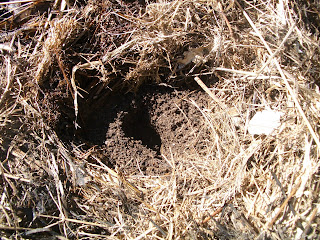All you need is raw organic cream from your cow (if necessary save it up for a few days to get a decent amount). In this example I use 1.25 litres. Pour the cream into a 2 litre glass jar. You can add yoghurt or kefir cultures at this stage, but I just let it sit as it is on the counter for 1 day and 2 nights to culture.
This is how the cream can look after a day and 2 nights. I now add a heaped tablespoon of seasalt to the cream (you can skip this if you prefer unsalted butter). I ensure the lid is tightly sealed, then wrap the jar in a tea towel, so that if the lid is not entirely liquid proof, I do not get any cream on my clothes...
I place one hand on the lid end and the other hand on the bottom end of the jar. Then I shake it slowly from side to side by moving the jar up and down like so:


Ensure the cream goes from top of the jar to the bottom of the jar in a nice steady rhythm. No need to rush, otherwise you will get tired before the butter has formed! The cream will get very thick at some point and will barely move inside the jar. Just keep going until it starts moving again. It will start sloshing around now, because the buttermilk will separate from the butter. It takes about 5 minutes of steady movement to get to this point.
Keep going for a bit longer until there is a fair amount of buttermilk that has separated from the butter. Don't worry, you'll know when it is time to stop! The butter and buttermilk now looks like this (see left)
I now put a wooden spoon into the glass jar to hold back the butter while I pour off the buttermilk. I use the buttermilk to make pancakes on weekends. After pouring off as much of the buttermilk as possible, I spoon the butter out of the jar with the wooden spoon, squeezing it against the side of the jar to get rid of any excess buttermilk.


I put the butter into a container, push the butter down in the container and drain any excess buttermilk. Store the butter and the buttermilk in the fridge. They both should keep at least a few weeks in the fridge. Enjoy!
















